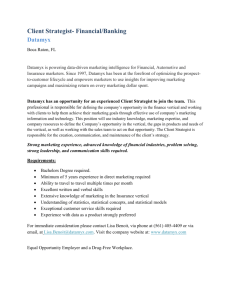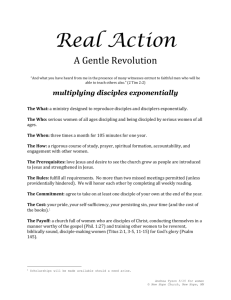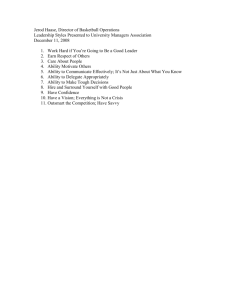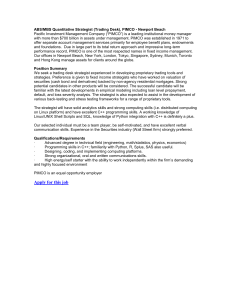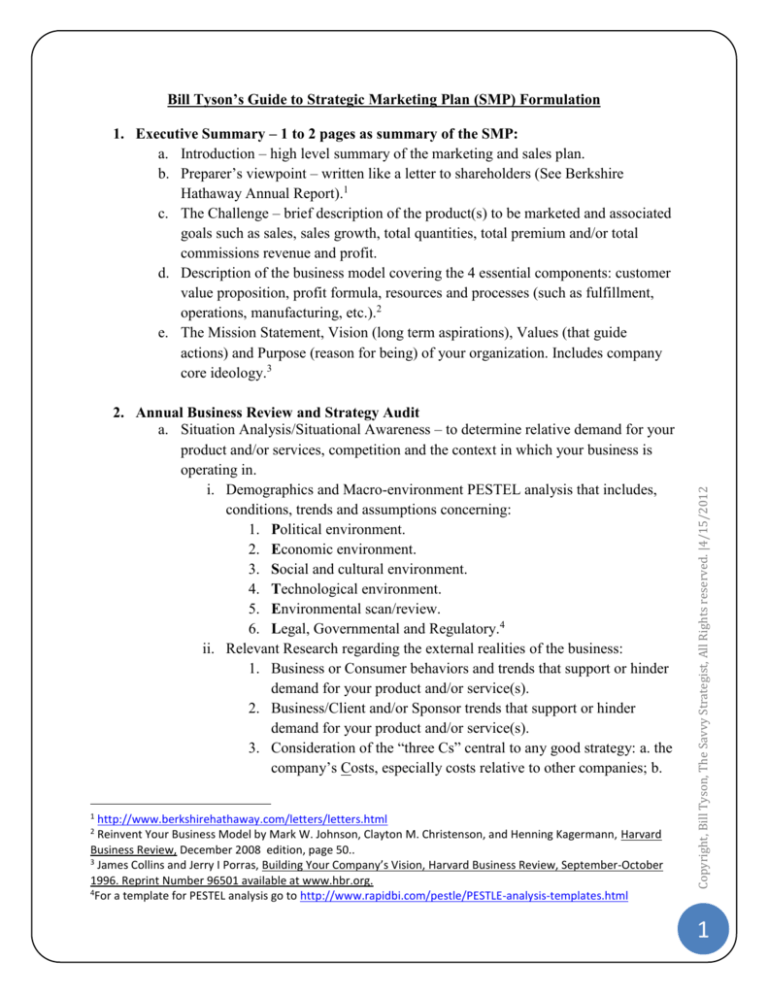
Bill Tyson’s Guide to Strategic Marketing Plan (SMP) Formulation
2. Annual Business Review and Strategy Audit
a. Situation Analysis/Situational Awareness – to determine relative demand for your
product and/or services, competition and the context in which your business is
operating in.
i. Demographics and Macro-environment PESTEL analysis that includes,
conditions, trends and assumptions concerning:
1. Political environment.
2. Economic environment.
3. Social and cultural environment.
4. Technological environment.
5. Environmental scan/review.
6. Legal, Governmental and Regulatory.4
ii. Relevant Research regarding the external realities of the business:
1. Business or Consumer behaviors and trends that support or hinder
demand for your product and/or service(s).
2. Business/Client and/or Sponsor trends that support or hinder
demand for your product and/or service(s).
3. Consideration of the “three Cs” central to any good strategy: a. the
company’s Costs, especially costs relative to other companies; b.
1
http://www.berkshirehathaway.com/letters/letters.html
Reinvent Your Business Model by Mark W. Johnson, Clayton M. Christenson, and Henning Kagermann, Harvard
Business Review, December 2008 edition, page 50..
3
James Collins and Jerry I Porras, Building Your Company’s Vision, Harvard Business Review, September-October
1996. Reprint Number 96501 available at www.hbr.org.
4
For a template for PESTEL analysis go to http://www.rapidbi.com/pestle/PESTLE-analysis-templates.html
2
Copyright, Bill Tyson, The Savvy Strategist, All Rights reserved. |4/15/2012
1. Executive Summary – 1 to 2 pages as summary of the SMP:
a. Introduction – high level summary of the marketing and sales plan.
b. Preparer’s viewpoint – written like a letter to shareholders (See Berkshire
Hathaway Annual Report).1
c. The Challenge – brief description of the product(s) to be marketed and associated
goals such as sales, sales growth, total quantities, total premium and/or total
commissions revenue and profit.
d. Description of the business model covering the 4 essential components: customer
value proposition, profit formula, resources and processes (such as fulfillment,
operations, manufacturing, etc.).2
e. The Mission Statement, Vision (long term aspirations), Values (that guide
actions) and Purpose (reason for being) of your organization. Includes company
core ideology.3
1
5
Kiechel, Walter (2010-03-03). Lords of Strategy: The Secret Intellectual History of the New Corporate World .
Perseus Books Group. Kindle Edition.
Copyright, Bill Tyson, The Savvy Strategist, All Rights reserved. |4/15/2012
the definition of the markets the company served—its Customers,
in other words—c. and its position vis à vis Competitors.5
iii. Direct Marketing/Marketing Environment/Trends:
1. Printing.
2. Production.
3. Postage.
4. Media consumption trends, and relative costs, etc.
5. Emerging channels and technologies.
6. Market and business risks – identification and mitigation (see
SWOT analysis below).
iv. Competitive reviews. See my web site at:
http://www.competitivereviews.com
1. Name, Market Position and Market share.
2. Strengths and weaknesses of each competitor.
3. Any anticipated moves and/or reaction by competitors.
4. Conduct a Michael Porter “Five Forces Analysis”.
v. Client trends that may negatively impact programs, channels
(telemarketing) or ability to market.
vi. S.W.O.T. analysis (see separate Power Point I developed on SWOT)
1. Internal – Strengths and Weaknesses.
2. External – Opportunities and Threats.
vii. Internal review and alignment - get your own house in order by
conducting an internal organizational effectiveness review. In order to
develop an organizational effectiveness improvement program for your
company, Booz & Co. has developed a “5 Step Organizational
Improvement program” simulator at www.simulatororgeffectiveness.com.
viii. Carriers, partners, distributors, vendor reviews and assessments, etc.
b. Company Analysis and Market Potential
i. Market Share - Current Universe vs. Total Market
ii. Mission, Goals, Focus and/or Vision (per the 1. Executive Summary
above)
iii. Competitive Advantages – how can we best compete against the next best
alternative?
1. Customers and/or markets that we target.
2. What is our customer value proposition?
3. Cost advantage?
2
v.
vi.
vii.
6
Robert S. Kaplan and David P. Norton, “Mastering the Management System”, Harvard Business Review published
January 2008, Page 6. See http://www.hbr.org Reprint #R0801D.
Copyright, Bill Tyson, The Savvy Strategist, All Rights reserved. |4/15/2012
iv.
4. What key processes give us a competitive advantage?
5. What is the human capital capabilities required to excel at these
key processes?
6. Differentiation advantage – activities we do differently than
competitors.
7. Tradeoffs - things that we choose not to do that other competitors
do.
8. Market share/penetration levels.
9. Key performance indicators – Us vs. the competition?
10. What are the Technology enablers of the strategy?
11. Is there a need to re-structure the organization?6
12. Summarize key points of differentiation. To what extent are you
delivering on the two essential ingredients for brand loyalty—
passion and comparative expertise?
Product and Services Capabilities (Value Creating Activities)
1. Competencies – innovation, quality, customer service, etc.
2. Proprietary know-how, process excellence, specialist knowledge,
technology, etc.
3. Marketing Software capability to support each media option in vii
below.
4. Installed customer base: Who, What, when, how much, why did
they buy?
5. Client contracts in place and duration.
6. Reputation of the firm.
7. Branding.
Market and/or Niche Description
1. % of total sales.
2. Answer WIFM/What they want or need.
3. How/why they use the product.
4. Support requirements.
5. How to reach them.
6. Price Sensitivity analysis.
Compensation model and/or changes relative to sales, partners, etc.
Media options that can be supported by the platform
1. DRTV.
2. Print (direct mail, statement inserts, out-of-home, etc.)
3. Mobile/SMS/Chat.
3
Copyright, Bill Tyson, The Savvy Strategist, All Rights reserved. |4/15/2012
4. Smart applications/interactive sites, games, to drive demand, leads
and sales, etc.
5. Contact Centers - Telesales.
6. Direct Sales – Agent/Sales Rep.
7. Events, webinars, tradeshows and speaking engagements.
8. Email.
9. Internal/external training and compliance.
10. Website, Microsites and PURLS.
11. Search – Paid Search, Pay Per Click, Search Engine Optimization,
Word of Mouth and viral marketing (e.g. YouTube videos).
12. Social Media - Blogs, Facebook, Linked In, MySpace, Twitter and
others.
13. Remote Brick and mortar – regional, branches, sales offices, etc.
viii. Customer profile description, the Customer Experience at every touch
point in the lifecycle:
1. Best customers/Top deciles of your prospect database.
2. Least desirable customers (for suppression purposes).
3. Value drivers.
4. Map customer experience, touch points and the decision making
process to purchase (and then repurchase).
ix. Current positioning of products and services, and the company as a whole,
in the marketplace.
c. Marketing and Distribution Channel Considerations – distribution is simply the
pipeline or path(s) a product or service takes from manufacturer/producer to
purchaser/consumer. Determining “Best fit” for the “Place” (of the 4 P’s) and
placement of your product or service requires the careful consideration of the
following:
i. Distribution Objectives that are developed, with intermediaries in mind,
who create value in one or more of the following ways:
1. Market intelligence, support and positioning the product via
customer value proposition and points of differentiation, tailored to
resonate with a specified target market.
2. Offer what I call real “Paths of least resistance” to accelerate new
market entry and/or current market initiators, customers, decision
makers, approvers and buyers.
3. Enables your company to “tap into” a wellspring of trust and
leverage from channel partner experts, consultants and
influencers who have a relationship and history with the
prospective client/consumer/end-user.
4
A Value Network is a system of partnerships and alliances used
by a firm to source, augment, and deliver its product or service
offerings.
Intermediaries that help get the product from manufacturer to
business, consumer or end users form the Marketing
Channel(s).
2. Captive (company-owned and operated), Exclusive (through
appointed independent organizations) and Non-exclusive
distribution arrangements. Typical boundaries in scope of
distribution relationships include:
a. By Geography
b. By Vertical (single industry i.e. affinity)
7
Marketing Management, by Philip Kotler and Kevin Keller, Chapter 14, 14th Edition, Prentice Hall, Upper Saddle
River, New Jersey, 2012.
Copyright, Bill Tyson, The Savvy Strategist, All Rights reserved. |4/15/2012
4. Offer resources and scalability – via shared service capabilities
in the form of:
a. Forward flow: co-marketing, sales and promotional
support; product management, negotiation of terms, pointof-sale transactions, delivery, problem solving, training,
fulfillment,
b. Backward flow: billing issues and handling
cancellations/returns, renewals, etc.
5. Synergies through co-development of new products, capabilities,
risk sharing and/or reverse flow opportunities (reciprocal
arrangements).
6. Added advantages or points of differentiation gained from
intermediary products in the form of product line extensions and/or
enhancements.
7. Pursuit of common financial goals – they also aspire to meet the
same or similar financial (i.e. production, sales and profit) goals.
See Strategic Marketing Plus, LLC Channel Partner Scorecard
spreadsheet.
8. Information and knowledge sharing - a necessary feedback loop
to improve efforts along the marketing, sales and customer
decision journey.
ii. Types of Distribution Relationships:
1. Value Networks and Marketing Channels7. Philip Kotler provides
these two definitions:
5
Copyright, Bill Tyson, The Savvy Strategist, All Rights reserved. |4/15/2012
c. By Horizontal (multiple industries)
d. By Product line
e. By Market – B2B, B2C or, however else you finely slice
the market(s).
3. Direct and Indirect. Indirect has one or more intermediary levels or
layers beginning with the manufacturer. Example: Insurance
industry:
a. Insurance Company
b. Wholesaler/Sponsor/MGA/MGU
c. Sub producer/Agent/Advisor
d. Consumer
4. Embedded or Standalone– where your product or service is
embedded in another product or service or sold standalone.
iii. Characteristics of robust distribution – what is also called “Best fit” –
supports the whole reason for engaging with intermediaries – knowledge,
resources, expertise, market presence, etc. 1. Similar or the same Target Customer(s) – ideally, where the
intermediary has a presence, and ideally, an installed client or
customer base that can be leveraged.
2. Operates a network of professional distributors who meet certain
minimum requirements (licenses, credentials, appointments,
approval process, contractual agreements in place, etc.), adhere to
guidelines, rules and written procedures and/or standards (quality
standards, Service level agreements, minimum production levels,
production quotas, etc.).
3. Adds value to a set of complimentary products and/or services.
4. Efficiently and productively delivers the product or service to the
intended purchaser.
5. Speeds up the sales cycle and purchasing process.
6. Possesses similar logistical and operational characteristics that can
be leveraged.
7. Competitive intelligence and operates as part of an “early warning”
system to signal competitor moves and changing market dynamics
(both good and bad).
iv. The stewards or managers of distribution relationships must prevent and
detect potential sources of channel conflict and address them quickly.
v. Set Distribution relationship goals via the Strategic Marketing Plus, LLC
Channel Partner Scorecard.
d. Results Reviews – where applicable ROMI Analysis is performed By:
i. Client or account.
6
Then, summarize and rate each of the 8 Profitability Drivers from 1 to 5 based upon
the outcome, actual versus the original plan. Determine what worked and what
didn’t work for each and develop an improvement plan with detailed corrective
actions.
iv. Additional Review Items:
1. Distribution Partner, Insurance Carrier, Broker and/or Agency
review. See Carrier Scorecard and Channel Partner scorecard
examples.
2. Vendor review/RFP Results (if applicable).
3. Operations – stability, scalability, defect remediation, address
bottlenecks, resource deficiencies and performance standards
(SLAs) review (actual vs. planned).
4. IT support, automation of marketing processes, etc.
5. CSR, Agent and/or broker Performance.
6. Call center performance – sales and/or services.
7. Underwriting results – by product; policy year, calendar year and
rolling 12 months basis.
8. Personnel Performance Reviews.
v. Marketing Plan Execution
1. Event execution
2. Test results
3. Key Lessons Learned Summary
Copyright, Bill Tyson, The Savvy Strategist, All Rights reserved. |4/15/2012
ii. List or lead source.
iii. Strategy Audit of what I call the 8 Profitability Drivers of Direct
Marketing:
1. Growth (and innovations) strategies. Successes to-date?
2. Product/Offers review.
a. Identification of product and services gaps.
b. New Product performance.
c. Trial offers to encourage use/adoption.
d. Adoption rate.
3. Database and Analytics - Segmentation, data and modeling
reviews.
4. Media performance review.
5. Contact plan review.
6. Inbound Channel effectiveness review.
7. Messaging review.
8. Creative development effort (formats, new creative tests, media
tests, etc.) review.
7
Copyright, Bill Tyson, The Savvy Strategist, All Rights reserved. |4/15/2012
a. What worked?
b. What didn’t work?
3. The Marketing Plan – Keep it Simple
a. Sensitivity analysis and “what if” scenarios tied to ROMI and strategies
i. Determine what metric improvements and key performance indicators
have the biggest impact.
ii. Utilize this analysis for developing strategies in the marketing plan
section.
iii. Develop alternative courses of action (Plans B, C and D).
b. Key Objective(s) of the Marketing Program(s) - Commit fully to one or two main
objectives then state it/them in the form of:
i. Quantitative – Growth, Revenue, Profit, etc.
ii. Qualitative - Value added to sponsor’s primary products; Diversification
(Should be General-to-Specific and in order of priority).
c. Focus on where it counts – the 8 Profitability Drivers for Strategy Development
i. Growth Strategies – using the 3 x 3 framework and consideration towards
developing “blue ocean” strategies to look across:
1. Path 1: Alternative Industries.
2. Path 2: Strategic Groups within industries.
3. Path 3: The chain of buyers for new, different segments.
4. Path 4: Complimentary Product and Service Offerings.
5. Path 5: Functional or emotional appeal to Buyers.
6. Path 6: Time.
ii. Product/Offer, 2 “Ds” and the 4 “Ps” – Marketing Mix Strategies
1. Description of the product and offer including product innovations.
2. Positioning.
3. Pricing.
4. Place
5. Distribution. (See distribution section Part 2: C above)
6. Promotions.
iii. Targeting, Data and Analytics Strategies
iv. Media Strategies
v. Contact Strategies
vi. Channel Development Strategies
vii. Messaging and Communications Strategies
viii. Creative Strategies – format, positioning, offer, etc.
d. Additional Strategy Areas:
i. Construct a Four Actions Framework and a new Value Curve:
1. Eliminate - Which factors that the industry takes for granted should
be eliminated?
8
88
W. Chan Kim and Renee Mauborgne, Blue Ocean Strategy, Harvard Business School Press. Copyright, 2005. Page
Copyright, Bill Tyson, The Savvy Strategist, All Rights reserved. |4/15/2012
2. Reduce – what factors should be reduced well below the industry
standard?
3. Create - which factors should be created that the industry has never
offered?
4. Raise – which factors should be increased or raised above the
industry standard8?
ii. Create the Eliminate, Reduce, Raise and Create Grid to drive action on
Value Innovation, based upon the 4 actions framework and new value
curve. Enables you to pursue differentiation and value-cost trade-offs
simultaneously.
iii. Measures to drive efficiency, information and knowledge i.e. technology,
marketing function automation, etc.
iv. New initiatives: developing new products, new markets and new service
capabilities. Refer to the 3 x 3 growth framework.
v. Identify Risks/Threats, obstacles and countermeasures to the Plan. (Per
SWOT). Also see 4. D below – Risks.
vi. Human Resources to Support the plan – hire and fire decisively but
carefully (…no one gets inspired by a hack!)
1. New hires/replacements.
2. Current vs. New organizational chart.
3. Justification to add staff.
4. Financial Projections, Plan Execution and Implementation
a. Marketing Department Budget
i. Account and campaign level detail.
ii. Any known business Risks related to each program (see 4 d below).
iii. Personnel review and assessment Campaign and test grids, by Client,
Product and Test cells.
iv. Media and/or list testing grid.
v. Description of new products, new offers and/or new creative concepts
under development.
b. Marketing Calendar summarizing by Month and Quarter:
i. List Accounts, individual events, creative splits, quantities, cost
summaries and financial targets.
ii. Develop an Action Plan: determine the description of the action, the
person responsible/responsible party (ies) and sequencing of your actions
and plans and priorities. Follow these 4 simple steps when developing an
action plan:
1. When should you take a specific action?
29
9
99
William A. Cohen, PHD, Major General USAF (retired), The Art of The Strategist. AMACOM Books, a division of
American Management Association, New York, NY. Copyright 2004.
10
See Bill Tyson’s blog, Strategy-In-Action at http://www.billtyson.wordpress.com and the post: “Making Critical
Decisions the RAPID Way”.
11
The Black Swan: Second Edition: The Impact of the Highly Improbable by Nassim Nicholas Taleb, Random Hose
Books 2010.
Copyright, Bill Tyson, The Savvy Strategist, All Rights reserved. |4/15/2012
2. What sequence should be followed?
3. What actions are continuous or repeated and at what intervals?
4. What actions are discrete?9
iii. Use RAPID for decision making. (see my separate blog posting)10
c. Operating Plan – to improve key processes, increase sales, evaluate resource
capacity and prepare a budget, pro forma and justification for each additional
resource. (Per 3.d.vi.)
d. Identification of Business Risks:
i. Risks that Affect Marketing:
1. Security or political risks – market disrupting events (so-called
“black swans”)11.
2. End-market risks – brand or reputation; customer consolidations,
etc.
3. Competitive risks
a. Disruptive technologies
b. New entrants
c. M&A
4. Regulatory and Legal
a. Legislation
b. Litigation
5. Financial or economic:
a. Financial market volatility
b. Recession
ii. Strategic and Business Risks Exhibit A: Sample Strategic and Business
Risks, much of what is listed here)
1. Strategic risks - are simply those that affect the strategic direction
of the organization.
2. Business risks - are those risks that have an impact on the day-today running of a business in terms of operational, product and
marketing risks. According Sayan Chatterjee, author of the
book Failsafe Strategies, the three business risks that can derail a
strategy are: demand risk, competitive risk and capability risk, as
defined:
a. Demand risk - is the risk that the value proposition that a
firm is trying to sell will not be accepted by the market or,
10
12
Failsafe Strategies, Sayan Chatterjee, Prentice Hall Books, 2005.
David Apgar, Risk Intelligence, Harvard Business School Press, Copyright 2006, page 12.
14
David Apgar, Risk Intelligence, Harvard Business School Press, Copyright 2006 page
15
Paul, B. Brown, Acceptance Loss, Conference Board Review Magazine, page70-71 Fall 2011.
16
W. Chan Kim and Renee Mauborgne, Blue Ocean Strategy, Harvard Business School Press. Copyright, 2005. Page
175.
13
Copyright, Bill Tyson, The Savvy Strategist, All Rights reserved. |4/15/2012
will be so accepted by the market that demand exceeds
supply causing a competitive risk.
b. Competitive risk - is the inability to cope with unexpected
demand making the firm susceptible to competitive
advances.
c. Capability risk - is the risk that a firm is not able to deliver
on the value proposition that customers are willing to pay
for or, the capabilities cost is so high that the firm cannot
make a satisfactory profit.12
iii. Risks that Affect Operations:
1. Operating risks – control and/or compliance failures
2. Supply chain risks – Supplier failure/disruption and key cost
volatility.
3. Technology risks – information security breach, infrastructure
breakdown, application failures, etc.
4. Workforce Risks – Workforce Capacity issues (from loss,
disruption, poor planning, etc.) and key staff defection(s).
5. Asset risks like: Fraud or theft, counterparty credit losses, etc.13
iv. Apply the 4 Rules of Risk Intelligence:
1. Recognize which risks are learnable.
2. Identify risks you can learn about fastest.
3. Sequence risky projects into a learning pipeline.
4. Keep networks of partners to manage all risks.14
v. Acceptance loss – similar to “stop loss” - is a concept that applies to
uncertain outcomes and managing the inherent downside risk of new
business ventures that consume time, resources and capital. Instead of
focusing on an expected return which may never materialize, this
approach identifies the point at which you limit your loss on risky
ventures.15
e. Gaining a Commitment to the Plan – requires Communication and Buy-in of the
Plan by everyone who is affected by it. Suggest following the Three Principles of
Fair Process (The 3 “E” Principles of Fair Process)16:
i. Engagement – involving the team in the strategic direction and decisions
that affect them allowing them to question, debate and discuss each
assumption and idea formulated as part of the strategy.
11
ii. Explanation – everyone involved and affected to understand why final
strategic decisions are made as they are, describing the thinking and
reasoning for the strategic direction.
iii. Expectation – clarity of the “new rules” of the game. It is critical that
everyone on the team understand expectations, what performance
standards will be used and standards that will be used to determine
acceptable performance and the penalties for failure.
To build peoples trust and commitment to the plan you need to build
execution into the strategy from the very start. This process helps to
minimize the risks of a failed plan due to distrust, non-cooperation and
sabotage.17
There are 5 Techniques to help you in gaining commitment to your strategy:
Think your goals through until they are clear and measurable.
Make a public commitment.
Promote your goals, strategies and objective(s).
Expect and deal with the obstacles. Also, see the next section.
Adjust your strategies (but not your objectives). 18
Also, is there an appropriate tag line you can devise that ties into your objective?
Example: “Operation Desert Storm” was the name of the first war the USA had
with Iraq.
f. Follow Dr. John Kotter’s 8 step process toward effective, lasting change,
summarized here:
Step 1.
Step 2.
17
Establish a Sense of Urgency:
Examine internal and external realities (via SWOT analysis).
Identify and deal with any crisis, potential crisis and key transformational
issues and opportunities.
Reinforce the idea that change is about creating a brighter, better, more
sustainable future.
Build the Guiding Team:
Pick a champion known for change leadership.
Ibid, page 172.
William A. Cohen, PHD, Major General USAF (retired), The Art of The Strategist. AMACOM Books, a division of
American Management Association, New York, NY. Copyright 2004. Page 31-32.
18
Copyright, Bill Tyson, The Savvy Strategist, All Rights reserved. |4/15/2012
1.
2.
3.
4.
5.
12
Step 3.
Step 4.
Step 5.
Step 6.
Step 7.
Assemble a team that is powerful enough to lead the initiative, made up of
key influencers.
Ignore the usual organizational hierarchies and encourage the group to
work as a team.
Establishing a dialogue of trust, candor and truth throughout the
organization is absolutely critical.
Get the Vision Right:
Create the vision for the change initiative.
Use the military approach of Commander’s Intent (CI).
Develop strategies for change.
If you cannot explain the vision in 5 minutes or less then you are NOT
finished with this important step.
Communicate for Buy-in:
You must use the art of persuasion and strike an “emotional cord”. Follow
Dan and Chip Heath’s advice on communicating ideas that stick:
Simplicity, Unexpectedness, Concreteness, Credibility, Emotional and
Stories.[8]
Use every vehicle to communicate the new vision.
Teaching/training new behaviors.
Show how this change initiative or turnaround plan is different from past
plans.
Develop and nurture a positive culture around change.
Empower Action/Remove Obstacles:
Identify and remove obstacles to change, including people who haven’t
bought into and support the change program.
Changing and/or eliminating systems/procedures that undermine change.
Encourage risk-taking, the exchange of non-traditional ideas, activities and
actions (proof positive change is underway).
Fight momentum killers - complacency, resistance, defiance, skepticism,
cynicism and pessimism whenever it surfaces.
Create Short-term Wins:
Plan for visible performance improvements – engineer short term wins.
Creating, implementing and rewarding employees involved in the
improvements.
Don’t let-up – Produce More Change – build on Your Quick Wins.
Copyright, Bill Tyson, The Savvy Strategist, All Rights reserved. |4/15/2012
13
Step 8.
Using increased credibility to change systems and policies further.
Hiring, promoting and developing employees who can implement the
vision.
Recognize setbacks are inevitable.
Reinvigorate the process with new projects, changes and themes.
Institutionalize change – Make Change Stick
Articulating the connections between the new behaviors and corporate
success.
Developing the means to ensure leadership development and succession.
Follow this mantra: “We see, we feel, we change”[9]
5. Delivering on Your Intent - Overcoming 4 Organizational Hurdles to Successful
Execution:
a. Issue a “Wake-up call” to employees on the team, expressing the need for a plan
and/or a new strategic direction to attack a new product, a new market or new
service capability.
b. Limited resources – the greater the shift in strategy, the greater the need for
resources.
c. Motivation – how do you ensure that key players are motivated?
d. Politics – how do triumph over the political forces that may inhibit your
successful execution?
6. Strategic Assessment: Determining whether your Strategic Marketing Plan is
Working (or not) and Adapt
a. Reliable Intelligence – through networking, weekly calls and visits on the ground.
b. Using your own Judgment – but giving those carrying out the plan the benefit of
the doubt.
c. Metric, Controlling and Reporting
i. Monthly Progress report – to Senior Management
1. Financials
2. Key Performance Indicators (KPIs)- Results summaries and
progress report. Identify any Strategy-to-Performance Gaps.19
3. Key Accomplishments
4. Key Priorities for the coming month
ii. Return on Marketing Investment reporting – occurs at the close of each
campaign.
19
Michael C. Mankins and Richard Steele, “Turning Great Strategy into Great Performance”, Harvard Business
Review, July-August 2005, Reprint numberR0507E at www.hbr.org.
Copyright, Bill Tyson, The Savvy Strategist, All Rights reserved. |4/15/2012
14
iii. Conduct Weekly Operational reviews regarding major initiatives to
improve processes, leverage technology, convert manual to automated
processes, etc.
iv. Conduct Monthly or Quarterly Strategic review sessions – to ensure that
the original objectives and strategies in the plan should continue as is, be
changed or postponed. Identify then close the Strategy-to-Performance
Gaps.
d. Quarterly report on Eliminate, Reduce, Raise and Create Grid progress.
e. Analysis of past, similar events and or plans and the outcomes.
f. Using the Delphi Method – structured method of collecting and distilling
knowledge from a panel of experts, surveys and questionnaires. 20
7. Stress-test Your Strategy By Answering these 7 Key Questions:
“The 7 Questions to Ask to Stress-Test Strategy Execution” by Robert Simon
2: How do your core values prioritize shareholders, employees, and customers?
Value statements and [the core customer value proposition] must go beyond just
aspirational ideals and address the interests of each constituency and when or where
tradeoffs need to be made.
3: What critical performance variables are you tracking? Since management’s time is
precious, are you looking at too many metrics on a regular basis? Keep an eye on metrics
that can mean the difference between success and failure of a strategy.
4: What strategic boundaries have you set? Have you clarified - What are people
supposed to do? What are they NOT to do?
5: How are you generating creative tension? First, you can do this by removing
insulation…make employees aware of all outside pressures (emanating from the Board,
Senior Management, Parent company, etc.).
6: How committed are your employees to helping each other? Assign everyone 5
stretch goals and have them report progress on a quarterly basis. Is there a spirit of
cooperation and fairness? Are employees helping one another? Rank employees based
upon individual performance and teamwork (via peer review).
20
William A. Cohen, PHD, Major General USAF (retired), The Art of The Strategist. AMACOM Books, a division of
American Management Association, New York, NY. Copyright 2004. Page 165.
Copyright, Bill Tyson, The Savvy Strategist, All Rights reserved. |4/15/2012
1: Who is your primary customer? As Gary Loveman, CEO of Harrah’s would
question: “Do you know or do you think you know?” Is there a heavy user segment?
How do you find more “look-a-likes”?
15
7: What strategic uncertainties keep you awake at night?21” What strategic
assumptions have proved to be false or wrong? Debates the assumptions, review results
and review the uncertainties to see if the validate or invalidate your strategies. Make
difficult choices and changes and adapt your strategy and action plans accordingly.
Bill Tyson, Chief Executive Officer, Strategic Marketing Plus, LLC. an independent strategy and
marketing consultancy firm based in Southern California. Before starting out on his own, Bill was the
EVP and COO of AMPAC Insurance Marketing of WNC First, one of the leading direct marketing
organizations selling term life insurance to customers of financial institutions. He has a strong direct
marketing background, business development, distribution, sales and multi-line insurance product
familiarity. Bill earned his Bachelor of Business Administration (BBA) in Insurance and Risk and
Business Law from Temple University. See also:
Bill Tyson’s Blog, The Savvy Strategist
How to Write a Great Business Plan, by William A. Sahlman, Harvard Business Review, JulyAugust 1997.
How good is your decision making ability? See Bain & Company’s Website Decide and
Deliver.
Turning Marketing Challenges into Opportunities
21
Copyright, Bill Tyson, The Savvy Strategist, All Rights reserved. |4/15/2012
About the Author:
Harvard Business Review, “Stress-Test Your Strategy The 7 Questions to Ask” By Robert Simons, November 2010.
16

